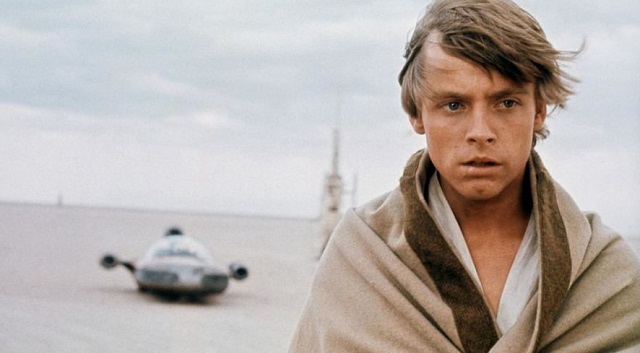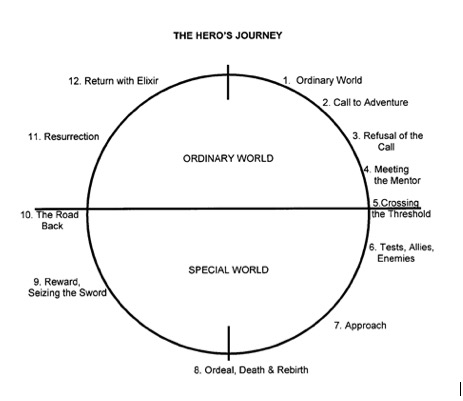
This is Part I of a three-part series. For Part II, here. For Part III, here. ~ ed.
~
You’re not the Victim, you’re the Hero: Part I.
I was kinda messed up after a particularly painful relationship breakup.
But, I decided to be mindful and look inward to see how my actions may have precipitated the breakup.
I started to map my relationship to the “Hero’s Journey.” It not only helped in my healing, but it gave me insights about how and why this relationship didn’t work out, and why it caused me so much pain.
The Hero’s Journey is a pattern of narrative identified by the American scholar, Joseph Campbell.
It appears in drama, storytelling, myth, religious ritual, and personal development.
I became interested in it when I was studying cinematography and learning how to create documentaries. Like most writers, I related to Campbell’s framework in telling stories and liked using it in my projects. What I didn’t realize, until I went through my breakup, is how helpful the Hero’s Journey metaphor can be for facing our everyday challenges and understanding ourselves better.
Campbell was the leading mythologist of his time—he studied all the great myth cultures and compared their stories. He found that one main storyline always exists within all epic stories: It describes the typical adventure of the archetype known as “The Hero.”
The hero is the person who goes out and achieves great deeds on behalf of himself, a group, or civilization. Many writers, as well as popular movies—from “The Wizard of Oz” to “Star Wars”—have used the Hero’s Journey framework,
At its highest level, the Hero’s Journey has three main parts.
Separation: The hero is in one kind of reality, and then suddenly separated from it.
Initiation: The hero is put into another place where he/she is somehow initiated.
Return: The hero returns to his/her village, home, or town to bring treasure and stories back.
If we have been through any kind of trauma and looked for meaning in it, we can benefit from relating this pattern to our own internal Hero’s Journey.
The beauty is that it allows us, maybe for the first time, to make sense of our suffering and triumphs in life. It also shows us why it seems like we are always on some kind of journey. No matter how long it takes to complete our own hero’s journey, when we return with treasure and tell our story, we immediately begin another one.
Any great hero movie will call on that hero within when we watch it. For Dorothy in “The Wizard Of Oz,” it isn’t just about defeating the wicked witch. It’s about claiming her own inner resources. At the end of the movie, she realizes that she had the ability to get back home all along by clicking her heels, but she needed to go through trials and tribulations to realize it. It’s the ordinary moving into the extraordinary.
The Hero’s Journey Never Ends.
This illustration shows the stages of the Hero’s Journey. The journey is depicted as a circle because the hero must always return to bring both the treasure of the victory and the stories of how it was accomplished so that others may find and partake in their own Hero’s Journey.

The key to using the Hero’s Journey as a light into our lives is to embrace metaphor.
We’ve all heard the story about the Knights of the Round Table and their epic search for the Holy Grail. The story is not about the grail itself; it’s about a more intangible thing. But the Holy Grail is the metaphor for that intangible feeling they are searching for.
Once we’re taught about a mythical character, just thinking of that character invokes their whole story and its meaning. Carl Jung called these archetypes.
They are encapsulated stories that plant a seed in our consciousness. When that archetypal seed—the mythical journey—is planted, it starts to sprout. It brings forth the relationships and patterns that help unfold the story we are journeying through. It’s much easier to have a story to help explain life than just an explanation. Stories are richer and move deeper into our psyche. So, it’s possible to follow these hero stories, see ourselves in them, and therefore manifest the reality of the hero moving through the journey to reap the reward.
The Call in the Crisis.
For the hero then, separation from the illusion of his/her life begins with the “call to adventure.”
The phone rings: The universe is literally dialing us up, asking us to step out and to live our journey. Something breaks into our reality and makes it impossible for us to continue on our current path. We can run away from it, but the call will keep coming until we finally answer it.
For many of us, this wake-up call comes in the form of a sledgehammer.
In “Star Wars,” Luke Skywalker comes back after talking with Obi Wan Kenobi to find his house burnt to the ground and his aunt and uncle killed. There is nothing left for him there—he has to go.
Often, the call comes in the depths of our despair: after losing a job, a health crisis, getting divorced, or having our house foreclosed. These aren’t the things we want to happen, but they are exactly what we need to awaken and catapult us into the next phase of our journey…
~
This is part one of a three-part series. Part II is here. And Part III, here.
~
~ Written by a recent Elephant Academy graduate. Learn to write & change your career for the mindfuller. Apply to Elephant Academy.~
~
Author: J. Scott MacMillan
Image: Star Wars, Return of the Jedi screenshot
Editor: Khara-Jade Warren










Read 0 comments and reply